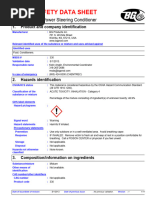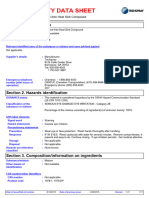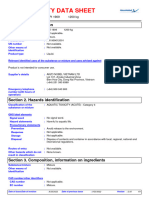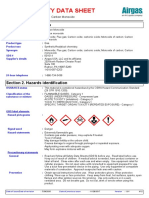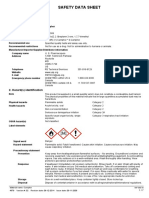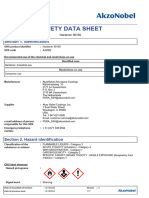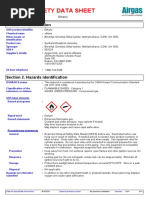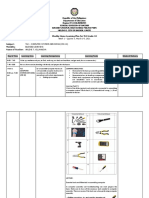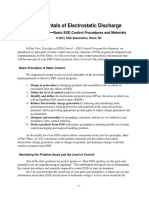MSDS 0009 G
MSDS 0009 G
Uploaded by
lanabacco13Copyright:
Available Formats
MSDS 0009 G
MSDS 0009 G
Uploaded by
lanabacco13Original Title
Copyright
Available Formats
Share this document
Did you find this document useful?
Is this content inappropriate?
Copyright:
Available Formats
MSDS 0009 G
MSDS 0009 G
Uploaded by
lanabacco13Copyright:
Available Formats
MATERIAL SAFETY DATA SHEET
Gas filter - Hydrocarbon
Conforms to US OSHA Hazard Communication 29CFR1910.1200
Section 1. Identification
This product is considered an article. This Safety Data Sheet is written based on the encapsulated substance or
mixture in this article.
1.1 Product identifier
Product name : Gas filter - Hydrocarbon
Part No. : 1035230
Validation date : 2016-01-29
1.2 Relevant identified uses of the substance or mixture and uses advised against
Material uses : Analytical chemistry.
100 ml
1.3 Details of the supplier of the safety data sheet
Supplier/Manufacturer : Trajan Scientific Australia Pty Ltd
7 Argent Place, Ringwood, Victoria 3134, Australia
Toll Free (Australia): 1800 257 213 | Tel: +61 (0) 3 9874 8577
www.trajanscimed.com
1.4 Emergency telephone number
In case of emergency : CHEMTREC®: 1-800-424-9300
Section 2. Hazards identification
This article, when used under reasonable conditions and in accordance with the directions for use, should not
present a health hazard. The substance or mixture is encapsulated in the article. Only if released due to use or
processing of the article in a manner not in accordance with the product’s directions for use it may present
potential health and safety hazards.
2.1 Classification of the substance or mixture
OSHA/HCS status : This material is considered hazardous by the OSHA Hazard Communication Standard
(29 CFR 1910.1200).
Classification of the substance or mixture
Comb. Dusts COMBUSTIBLE DUSTS
2.2 GHS label elements
Signal word : Warning
Hazard statements : No Code(s) - May form combustible dust concentrations in air.
Precautionary statements
Prevention : Not applicable.
Response : Not applicable.
Storage : Not applicable.
Disposal : Not applicable.
Supplemental label : Keep container tightly closed. Keep away from heat, hot surfaces, sparks, open flames
elements and other ignition sources. No smoking. Prevent dust accumulation.
2.3 Other hazards
Hazards not otherwise : Handling and/or processing of this material may generate a dust which can cause
classified mechanical irritation of the eyes, skin, nose and throat.
Date of issue : 01/29/2016 1/10
Gas filter - Hydrocarbon
Section 3. Composition/information on ingredients
This article, when used under reasonable conditions and in accordance with the directions for use, should not
present a health hazard. The substance or mixture is encapsulated in the article. Only if released due to use or
processing of the article in a manner not in accordance with the product’s directions for use it may present
potential health and safety hazards.
Substance/mixture : Substance (encapsulated in article)
Ingredient name % CAS number
carbon 100 7440-44-0
Any concentration shown as a range is to protect confidentiality or is due to batch variation.
There are no additional ingredients present which, within the current knowledge of the supplier and in the
concentrations applicable, are classified as hazardous to health or the environment and hence require reporting
in this section.
Occupational exposure limits, if available, are listed in Section 8.
Section 4. First aid measures
4.1 Description of necessary first aid measures
Eye contact : Immediately flush eyes with plenty of water, occasionally lifting the upper and lower
eyelids. Check for and remove any contact lenses. Continue to rinse for at least 10
minutes. Get medical attention if irritation occurs.
Inhalation : Remove victim to fresh air and keep at rest in a position comfortable for breathing. If
not breathing, if breathing is irregular or if respiratory arrest occurs, provide artificial
respiration or oxygen by trained personnel. It may be dangerous to the person providing
aid to give mouth-to-mouth resuscitation. Get medical attention if adverse health effects
persist or are severe. If unconscious, place in recovery position and get medical
attention immediately. Maintain an open airway. Loosen tight clothing such as a collar,
tie, belt or waistband.
Skin contact : Wash contaminated skin with soap and water. Remove contaminated clothing and
shoes. Get medical attention if symptoms occur. Wash clothing before reuse. Clean
shoes thoroughly before reuse.
Ingestion : Wash out mouth with water. Remove dentures if any. Remove victim to fresh air and
keep at rest in a position comfortable for breathing. If material has been swallowed and
the exposed person is conscious, give small quantities of water to drink. Stop if the
exposed person feels sick as vomiting may be dangerous. Do not induce vomiting
unless directed to do so by medical personnel. If vomiting occurs, the head should be
kept low so that vomit does not enter the lungs. Get medical attention if adverse health
effects persist or are severe. Never give anything by mouth to an unconscious person.
If unconscious, place in recovery position and get medical attention immediately.
Maintain an open airway. Loosen tight clothing such as a collar, tie, belt or waistband.
4.2 Most important symptoms/effects, acute and delayed
Potential acute health effects
Eye contact : Exposure to airborne concentrations above statutory or recommended exposure limits
may cause irritation of the eyes.
Inhalation : Exposure to airborne concentrations above statutory or recommended exposure limits
may cause irritation of the nose, throat and lungs.
Skin contact : No known significant effects or critical hazards.
Ingestion : No known significant effects or critical hazards.
Over-exposure signs/symptoms
Eye contact : Adverse symptoms may include the following:
irritation
redness
Date of issue : 01/29/2016 2/10
Gas filter - Hydrocarbon
Section 4. First aid measures
Inhalation : Adverse symptoms may include the following:
respiratory tract irritation
coughing
Skin contact : No specific data.
Ingestion : No specific data.
4.3 Indication of immediate medical attention and special treatment needed, if necessary
Notes to physician : Treat symptomatically. Contact poison treatment specialist immediately if large
quantities have been ingested or inhaled.
Specific treatments : No specific treatment.
Protection of first-aiders : No action shall be taken involving any personal risk or without suitable training. It may
be dangerous to the person providing aid to give mouth-to-mouth resuscitation.
See toxicological information (Section 11)
Section 5. Fire-fighting measures
5.1 Extinguishing media
Suitable extinguishing : Use dry chemical powder.
media
Unsuitable extinguishing : Avoid high pressure media which could cause the formation of a potentially explosible
media dust-air mixture.
5.2 Special hazards arising from the substance or mixture
Specific hazards arising : May form explosible dust-air mixture if dispersed.
from the chemical
Hazardous thermal : Decomposition products may include the following materials:
decomposition products carbon dioxide
carbon monoxide
5.3 Advice for firefighters
Special protective actions : Promptly isolate the scene by removing all persons from the vicinity of the incident if
for fire-fighters there is a fire. No action shall be taken involving any personal risk or without suitable
training. Move containers from fire area if this can be done without risk. Use water
spray to keep fire-exposed containers cool.
Special protective : Fire-fighters should wear appropriate protective equipment and self-contained
equipment for fire-fighters breathing apparatus (SCBA) with a full face-piece operated in positive pressure mode.
Remark : Material in powder form, capable of creating a dust explosion.
Section 6. Accidental release measures
6.1 Personal precautions, protective equipment and emergency procedures
For non-emergency : No action shall be taken involving any personal risk or without suitable training.
personnel Evacuate surrounding areas. Keep unnecessary and unprotected personnel from
entering. Do not touch or walk through spilled material. Shut off all ignition sources.
No flares, smoking or flames in hazard area. Avoid breathing dust. Provide adequate
ventilation. Wear appropriate respirator when ventilation is inadequate. Put on
appropriate personal protective equipment.
For emergency responders : If specialized clothing is required to deal with the spillage, take note of any information in
Section 8 on suitable and unsuitable materials. See also the information in "For non-
emergency personnel".
Date of issue : 01/29/2016 3/10
Gas filter - Hydrocarbon
Section 6. Accidental release measures
6.2 Environmental : Avoid dispersal of spilled material and runoff and contact with soil, waterways, drains
precautions and sewers. Inform the relevant authorities if the product has caused environmental
pollution (sewers, waterways, soil or air).
6.3 Methods and materials for containment and cleaning up
Methods for cleaning up : Move containers from spill area. Use spark-proof tools and explosion-proof equipment.
Vacuum or sweep up material and place in a designated, labeled waste container.
Dispose of via a licensed waste disposal contractor.
Section 7. Handling and storage
7.1 Precautions for safe handling
Protective measures : Put on appropriate personal protective equipment (see Section 8). Do not ingest. Avoid
contact with eyes, skin and clothing. Avoid breathing dust. Avoid the creation of dust
when handling and avoid all possible sources of ignition (spark or flame). Prevent dust
accumulation. Use only with adequate ventilation. Wear appropriate respirator when
ventilation is inadequate. Keep in the original container or an approved alternative
made from a compatible material, kept tightly closed when not in use. Electrical
equipment and lighting should be protected to appropriate standards to prevent dust
coming into contact with hot surfaces, sparks or other ignition sources. Take
precautionary measures against electrostatic discharges. To avoid fire or explosion,
dissipate static electricity during transfer by grounding and bonding containers and
equipment before transferring material. Empty containers retain product residue and
can be hazardous. Do not reuse container.
Advice on general : Eating, drinking and smoking should be prohibited in areas where this material is
occupational hygiene handled, stored and processed. Workers should wash hands and face before eating,
drinking and smoking. Remove contaminated clothing and protective equipment before
entering eating areas. See also Section 8 for additional information on hygiene
measures.
7.2 Conditions for safe : Storage temperature: 25°C (77°F). Store in accordance with local regulations. Store in
storage, including any a segregated and approved area. Store in original container protected from direct
incompatibilities sunlight in a dry, cool and well-ventilated area, away from incompatible materials (see
Section 10) and food and drink. Eliminate all ignition sources. Separate from oxidizing
materials. Keep container tightly closed and sealed until ready for use. Containers that
have been opened must be carefully resealed and kept upright to prevent leakage. Do
not store in unlabeled containers. Use appropriate containment to avoid environmental
contamination.
7.3 Specific end use(s)
Recommendations : Industrial applications, Professional applications.
Industrial sector specific : Not applicable.
solutions
Section 8. Exposure controls/personal protection
Since the hazardous ingredient in this article is encapsulated, the risk of exposure by inhalation, ingestion, skin
contact and eyes contact is minimum.
8.1 Control parameters
Occupational exposure limits
Ingredient name Exposure limits
carbon None.
8.2 Exposure controls
Date of issue : 01/29/2016 4/10
Gas filter - Hydrocarbon
Section 8. Exposure controls/personal protection
Appropriate engineering : Use only with adequate ventilation. If user operations generate dust, fumes, gas, vapor
controls or mist, use process enclosures, local exhaust ventilation or other engineering controls
to keep worker exposure to airborne contaminants below any recommended or statutory
limits. The engineering controls also need to keep gas, vapor or dust concentrations
below any lower explosive limits. Use explosion-proof ventilation equipment.
Environmental exposure : Emissions from ventilation or work process equipment should be checked to ensure
controls they comply with the requirements of environmental protection legislation. In some
cases, fume scrubbers, filters or engineering modifications to the process equipment
will be necessary to reduce emissions to acceptable levels.
Individual protection measures
Hygiene measures : Wash hands, forearms and face thoroughly after handling chemical products, before
eating, smoking and using the lavatory and at the end of the working period.
Appropriate techniques should be used to remove potentially contaminated clothing.
Wash contaminated clothing before reusing. Ensure that eyewash stations and safety
showers are close to the workstation location.
Eye/face protection : Safety eyewear complying with an approved standard should be used when a risk
assessment indicates this is necessary to avoid exposure to liquid splashes, mists,
gases or dusts. If contact is possible, the following protection should be worn, unless
the assessment indicates a higher degree of protection: safety glasses with side-
shields. If operating conditions cause high dust concentrations to be produced, use
dust goggles.
Skin protection
Hand protection : Chemical-resistant, impervious gloves complying with an approved standard should be
worn at all times when handling chemical products if a risk assessment indicates this is
necessary. Considering the parameters specified by the glove manufacturer, check
during use that the gloves are still retaining their protective properties. It should be
noted that the time to breakthrough for any glove material may be different for different
glove manufacturers. In the case of mixtures, consisting of several substances, the
protection time of the gloves cannot be accurately estimated.
Body protection : Personal protective equipment for the body should be selected based on the task being
performed and the risks involved and should be approved by a specialist before
handling this product.
Other skin protection : Appropriate footwear and any additional skin protection measures should be selected
based on the task being performed and the risks involved and should be approved by a
specialist before handling this product.
Respiratory protection : Based on the hazard and potential for exposure, select a respirator that meets the
appropriate standard or certification. Respirators must be used according to a
respiratory protection program to ensure proper fitting, training, and other important
aspects of use.
Section 9. Physical and chemical properties
9.1 Information on basic physical and chemical properties
Appearance
Physical state : Solid. [Granular solid.]
Color : Black.
Odor : None
Odor threshold : Not available.
pH : Not available.
Melting point : 3652°C (6605.6°F)
Boiling point : Not available.
Flash point : Not available.
Date of issue : 01/29/2016 5/10
Gas filter - Hydrocarbon
Section 9. Physical and chemical properties
Evaporation rate : Not applicable.
Flammability (solid, gas) : Flammable in the presence of the following materials or conditions: open flames, sparks
and static discharge and heat.
Lower and upper explosive : Not available.
(flammable) limits
Vapor pressure : Not available.
Vapor density : Not available.
Relative density : 1.9 to 2.2 [Water = 1]
Density : 1.9 to 2.2 g/cm³ [25°C (77°F)]
Solubility : Insoluble in the following materials: cold water and hot water.
Solubility in water : 0 g/l
Partition coefficient: n- : Not available.
octanol/water
Auto-ignition temperature : 452°C (845.6°F)
Decomposition temperature : Not available.
Viscosity : Not available.
Section 10. Stability and reactivity
10.1 Reactivity : No specific test data related to reactivity available for this product or its ingredients.
10.2 Chemical stability : The product is stable.
10.3 Possibility of : Under normal conditions of storage and use, hazardous reactions will not occur.
hazardous reactions
10.4 Conditions to avoid : Avoid the creation of dust when handling and avoid all possible sources of ignition
(spark or flame). Take precautionary measures against electrostatic discharges. To
avoid fire or explosion, dissipate static electricity during transfer by grounding and
bonding containers and equipment before transferring material. Prevent dust
accumulation.
10.5 Incompatible materials : Reactive or incompatible with the following materials:
oxidizing materials
Incompatible with: acids.
10.6 Hazardous : Under normal conditions of storage and use, hazardous decomposition products should
decomposition products not be produced.
Section 11. Toxicological information
11.1 Information on toxicological effects
Acute toxicity
Not available.
Irritation/Corrosion
Not available.
Sensitization
Not available.
Mutagenicity
Date of issue : 01/29/2016 6/10
Gas filter - Hydrocarbon
Section 11. Toxicological information
Not available.
Carcinogenicity
Not available.
Reproductive toxicity
Not available.
Teratogenicity
Not available.
Specific target organ toxicity (single exposure)
Not available.
Specific target organ toxicity (repeated exposure)
Not available.
Aspiration hazard
Not available.
Information on the likely : Routes of entry anticipated: Oral, Dermal, Inhalation.
routes of exposure
Potential acute health effects
Eye contact : Exposure to airborne concentrations above statutory or recommended exposure limits
may cause irritation of the eyes.
Inhalation : Exposure to airborne concentrations above statutory or recommended exposure limits
may cause irritation of the nose, throat and lungs.
Skin contact : No known significant effects or critical hazards.
Ingestion : No known significant effects or critical hazards.
Symptoms related to the physical, chemical and toxicological characteristics
Eye contact : Adverse symptoms may include the following:
irritation
redness
Inhalation : Adverse symptoms may include the following:
respiratory tract irritation
coughing
Skin contact : No specific data.
Ingestion : No specific data.
Delayed and immediate effects and also chronic effects from short and long term exposure
Short term exposure
Potential immediate : Not available.
effects
Potential delayed effects : Not available.
Long term exposure
Potential immediate : Not available.
effects
Potential delayed effects : Not available.
Potential chronic health effects
General : Repeated or prolonged inhalation of dust may lead to chronic respiratory irritation.
Carcinogenicity : No known significant effects or critical hazards.
Date of issue : 01/29/2016 7/10
Gas filter - Hydrocarbon
Section 11. Toxicological information
Mutagenicity : No known significant effects or critical hazards.
Teratogenicity : No known significant effects or critical hazards.
Developmental effects : No known significant effects or critical hazards.
Fertility effects : No known significant effects or critical hazards.
Numerical measures of toxicity
Acute toxicity estimates
Not available.
Section 12. Ecological information
12.1 Toxicity
Not available.
12.2 Persistence and degradability
Not available.
12.3 Bioaccumulative potential
Not available.
12.4 Mobility in soil
Soil/water partition : Not available.
coefficient (KOC)
12.5 Other adverse effects : No known significant effects or critical hazards.
Section 13. Disposal considerations
13.1 Waste treatment methods
Disposal methods : The generation of waste should be avoided or minimized wherever possible. Disposal
of this product, solutions and any by-products should at all times comply with the
requirements of environmental protection and waste disposal legislation and any
regional local authority requirements. Dispose of surplus and non-recyclable products
via a licensed waste disposal contractor. Waste should not be disposed of untreated to
the sewer unless fully compliant with the requirements of all authorities with jurisdiction.
Waste packaging should be recycled. Incineration or landfill should only be considered
when recycling is not feasible. This material and its container must be disposed of in a
safe way. Care should be taken when handling emptied containers that have not been
cleaned or rinsed out. Empty containers or liners may retain some product residues.
Avoid dispersal of spilled material and runoff and contact with soil, waterways, drains
and sewers.
Disposal should be in accordance with applicable regional, national and local laws and regulations. Local
regulations may be more stringent than regional or national requirements.
The information presented below only applies to the material as supplied. The identification based on
characteristic(s) or listing may not apply if the material has been used or otherwise contaminated. It is the
responsibility of the waste generator to determine the toxicity and physical properties of the material generated to
determine the proper waste identification and disposal methods in compliance with applicable regulations.
Date of issue : 01/29/2016 8/10
Gas filter - Hydrocarbon
Section 13. Disposal considerations
Refer to Section 7: HANDLING AND STORAGE and Section 8: EXPOSURE CONTROLS/PERSONAL PROTECTION
for additional handling information and protection of employees.
Section 14. Transport information
This Safety Data Sheet is written based on the encapsulated substance or mixture in this article. Since the
hazardous ingredient is encapsulated, the risk of exposure by inhalation, ingestion, skin contact and eyes contact
is minimum.
Regulatory information
DOT / IMDG / IATA : Not regulated.
Section 15. Regulatory information
15.1 Safety, health and environmental regulations/legislation specific for the substance or mixture
U.S. Federal regulations : TSCA 8(a) CDR Exempt/Partial exemption: This material is listed or exempted.
United States inventory (TSCA 8b): This material is listed or exempted.
Clean Air Act Section 112 : Not listed
(b) Hazardous Air
Pollutants (HAPs)
Clean Air Act Section 602 : Not listed
Class I Substances
Clean Air Act Section 602 : Not listed
Class II Substances
DEA List I Chemicals : Not listed
(Precursor Chemicals)
DEA List II Chemicals : Not listed
(Essential Chemicals)
SARA 302/304
Composition/information on ingredients
No products were found.
SARA 304 RQ : Not applicable.
SARA 311/312
Classification : Fire hazard
Composition/information on ingredients
Name % Fire Sudden Reactive Immediate Delayed
hazard release of (acute) (chronic)
pressure health health
hazard hazard
carbon 100 Yes. No. No. No. No.
State regulations
Massachusetts : This material is not listed.
New York : This material is not listed.
New Jersey : This material is not listed.
Pennsylvania : This material is not listed.
California Prop. 65
No products were found.
Canada inventory : This material is listed or exempted.
Date of issue : 01/29/2016 9/10
Gas filter - Hydrocarbon
Section 15. Regulatory information
International regulations
International lists : Australia inventory (AICS): This material is listed or exempted.
China inventory (IECSC): This material is listed or exempted.
Japan inventory (ENCS): This material is listed or exempted.
Japan inventory (ISHL): Not determined.
Korea inventory: This material is listed or exempted.
Malaysia Inventory (EHS Register): This material is listed or exempted.
New Zealand Inventory of Chemicals (NZIoC): This material is listed or exempted.
Philippines inventory (PICCS): This material is listed or exempted.
Taiwan Chemical Substances Inventory (TCSI): This material is listed or exempted.
Turkey inventory: This material is listed or exempted.
Chemical Weapons : Not listed
Convention List Schedule
I Chemicals
Chemical Weapons : Not listed
Convention List Schedule
II Chemicals
Chemical Weapons : Not listed
Convention List Schedule
III Chemicals
Section 16. Other information
History
Date of issue : 01/29/2016
Date of previous issue : 12/23/2013.
Version : 2.11
Indicates information that has changed from previously issued version.
Notice to reader
Disclaimer: The information contained in this document is based on the manufacturer's state of knowledge at the
time of preparation. No warranty as to its accurateness, completeness or suitability for a particular purpose is
expressed or implied.
MSDS-0009-G © Trajan Scientific Australia Pty Ltd
Date of issue : 01/29/2016 10/10
You might also like
- HLC-8320GPC OperatorsManual GDocument199 pagesHLC-8320GPC OperatorsManual GPrianurraufikachmadNo ratings yet
- Doosan MG400-V Shop ManualDocument618 pagesDoosan MG400-V Shop Manualmarjan43100% (8)
- MSDS-PELLASTOL 94 S - EnglishDocument13 pagesMSDS-PELLASTOL 94 S - EnglishRaajha MunibathiranNo ratings yet
- Dual RS485 Option Module Install Guide LON Option Module (12978) Install SheetDocument4 pagesDual RS485 Option Module Install Guide LON Option Module (12978) Install SheetHamza Esad ÇAKMAK100% (1)
- Electrical Safety ProcedureDocument33 pagesElectrical Safety ProcedurePraful E. Pawar100% (1)
- Snoop Soap SolutionDocument11 pagesSnoop Soap SolutionskandagroupsblrNo ratings yet
- US00405-3200053201 CO2Document10 pagesUS00405-3200053201 CO2Duong BachNo ratings yet
- Anti Foaming Liquid-MSDSDocument11 pagesAnti Foaming Liquid-MSDSsandeep HSENo ratings yet
- Power Steering ConditionerDocument11 pagesPower Steering ConditionerasesorNo ratings yet
- Heat Sink Compound MSDSDocument11 pagesHeat Sink Compound MSDSrameshqapcbaNo ratings yet
- Mortein FKD Fly & Mosquito Killer Aerosol, All Scents-V6.2-D0067111 PDFDocument11 pagesMortein FKD Fly & Mosquito Killer Aerosol, All Scents-V6.2-D0067111 PDFAbbas AlzydiNo ratings yet
- Lean MDEA HFCDocument9 pagesLean MDEA HFCthomasjohn90909013No ratings yet
- SDS 3200043831 Mg(ClO4)2-Document10 pagesSDS 3200043831 Mg(ClO4)2-Duong BachNo ratings yet
- Sds Poly Guard FDA 32 Us EngDocument10 pagesSds Poly Guard FDA 32 Us EngÆ José TonatiuNo ratings yet
- Cat Cooling System CleanerDocument12 pagesCat Cooling System CleanerEslam MahfouzNo ratings yet
- Safety Data Sheet: Blue DyeDocument13 pagesSafety Data Sheet: Blue DyeAsh BuzNo ratings yet
- SDS Epi 1909 en 220923Document9 pagesSDS Epi 1909 en 220923juprykaNo ratings yet
- Blb8002f Sds SGP Eng WT ActDocument7 pagesBlb8002f Sds SGP Eng WT ActKhizar NaqviNo ratings yet
- BHT-MSDS (Lanxess)Document10 pagesBHT-MSDS (Lanxess)phanquyentrinh11No ratings yet
- n-BUTANE RAW MAT MSDSDocument11 pagesn-BUTANE RAW MAT MSDSJustin Marc EstiponaNo ratings yet
- Q05693 - Quadra - Canada (CA) SDS HPR 2015 - EngDocument10 pagesQ05693 - Quadra - Canada (CA) SDS HPR 2015 - EngJean GrégoireNo ratings yet
- Mobil Aero Hfa-2024Document12 pagesMobil Aero Hfa-2024stk28892No ratings yet
- Dur 505 - 350Document9 pagesDur 505 - 350DebNo ratings yet
- Hitec614 - Sds-EnglishDocument8 pagesHitec614 - Sds-EnglishenriqueNo ratings yet
- SDS Astroglow Additive NA EnglishDocument9 pagesSDS Astroglow Additive NA EnglishballistictoddNo ratings yet
- DOPO-Me Bisphenol - UN Form SDS PDFDocument9 pagesDOPO-Me Bisphenol - UN Form SDS PDFAl RammohanNo ratings yet
- Cumene DatasheetDocument12 pagesCumene DatasheetDiana BanuNo ratings yet
- Bhi SCW203Document10 pagesBhi SCW203Seoudi AbdelhafidNo ratings yet
- SDS Epi 1970 en 220923Document10 pagesSDS Epi 1970 en 220923juprykaNo ratings yet
- Blb9742 Sds Sgp Eng Wt ActDocument8 pagesBlb9742 Sds Sgp Eng Wt ActeshrakalrashidxNo ratings yet
- Sds c936 Albegal SetDocument14 pagesSds c936 Albegal SetANGELA NUEZNo ratings yet
- Safety Data Sheet: Section 1. IdentificationDocument11 pagesSafety Data Sheet: Section 1. IdentificationBalaji SNo ratings yet
- Safety Data Sheet: Section 1. IdentificationDocument12 pagesSafety Data Sheet: Section 1. IdentificationCarlos MadridNo ratings yet
- Safety Data Sheet: Section 1. IdentificationDocument10 pagesSafety Data Sheet: Section 1. IdentificationReniNo ratings yet
- Safety Data Sheet: 1. IdentificationDocument7 pagesSafety Data Sheet: 1. IdentificationNur HasanahNo ratings yet
- Safety Data Sheet: Section 1. IdentificationDocument13 pagesSafety Data Sheet: Section 1. IdentificationMohammed Shuaib AhmedNo ratings yet
- SDS - Nasiol PerShine - Phial v0.1Document10 pagesSDS - Nasiol PerShine - Phial v0.1Can KaraküçükNo ratings yet
- Preconditioner Unit - Temperature - 40C - NAEnglishDocument12 pagesPreconditioner Unit - Temperature - 40C - NAEnglishKartik WadhwaNo ratings yet
- ANA Hardener 90150 SG6NDocument11 pagesANA Hardener 90150 SG6NAgung Wahyu WidodoNo ratings yet
- SDS 20880 Fenomastic Hygiene Emulsion Matt Euk SADocument9 pagesSDS 20880 Fenomastic Hygiene Emulsion Matt Euk SAJohn SabestianNo ratings yet
- FORSA™ SCW237 SCALE INHIBITORDocument12 pagesFORSA™ SCW237 SCALE INHIBITORMolybdnum ChannelNo ratings yet
- Novasol Yellow 3R MD MSDSDocument10 pagesNovasol Yellow 3R MD MSDSalamin781132No ratings yet
- MSDS - Dipentamethylenethiuram HexasulphideDocument12 pagesMSDS - Dipentamethylenethiuram HexasulphideBeh Jyh JiunnNo ratings yet
- CP400 ChemPadDocument12 pagesCP400 ChemPadMariajosé Cabrera MuñozNo ratings yet
- Lewatit Monoplus S 108 KRDocument8 pagesLewatit Monoplus S 108 KRcabooseNo ratings yet
- Safety Data Sheet: Section 1. IdentificationDocument12 pagesSafety Data Sheet: Section 1. IdentificationWici WiciNo ratings yet
- SDS PSF 2cSt Silicone Bath FluidDocument9 pagesSDS PSF 2cSt Silicone Bath FluidPedro PérezNo ratings yet
- Vanish Napisan Plus Powder-V2-D8341587Document10 pagesVanish Napisan Plus Powder-V2-D8341587AngeliaGaluchNingTiasNo ratings yet
- SDS Hardener 2750 EN 221004Document10 pagesSDS Hardener 2750 EN 221004juprykaNo ratings yet
- Sds Zincanode 330 Powder SdsDocument9 pagesSds Zincanode 330 Powder SdscreatorsjkNo ratings yet
- WAW436XDocument12 pagesWAW436XMolybdnum ChannelNo ratings yet
- MSDS Isopropyl AlcoholDocument12 pagesMSDS Isopropyl AlcoholrezaNo ratings yet
- MSDS Rust-Remover-SDS5048Document7 pagesMSDS Rust-Remover-SDS5048nikoNo ratings yet
- delopurBDocument11 pagesdelopurBSami LAHMIDINo ratings yet
- Barrier Fluid Fda 22 SDSDocument10 pagesBarrier Fluid Fda 22 SDSahmedalgaloNo ratings yet
- Safety Data Sheet: Section 1. IdentificationDocument11 pagesSafety Data Sheet: Section 1. IdentificationCorvetteNo ratings yet
- Ammonia MsdsDocument12 pagesAmmonia Msdsclear water100% (1)
- Safety Data Sheet: Section 1. IdentificationDocument11 pagesSafety Data Sheet: Section 1. IdentificationSubburamNo ratings yet
- Msds Sulfur Hexafluoride - AirgasDocument11 pagesMsds Sulfur Hexafluoride - AirgastolmiltNo ratings yet
- CW2500 Part A - ISS 26052015Document10 pagesCW2500 Part A - ISS 26052015mitramgopalNo ratings yet
- ANA Hardener 90121 SG6NDocument10 pagesANA Hardener 90121 SG6NAgung Wahyu WidodoNo ratings yet
- Safety Data Sheet: Section 1. IdentificationDocument11 pagesSafety Data Sheet: Section 1. Identificationmuhammadarif46No ratings yet
- ANA Aerobase Curing Solution SG6NDocument11 pagesANA Aerobase Curing Solution SG6NAgung Wahyu WidodoNo ratings yet
- Stepping Motor ControlDocument22 pagesStepping Motor Controlabuzer1981100% (1)
- MSDS-BC Styrene Monomer(苯乙烯单体)Document23 pagesMSDS-BC Styrene Monomer(苯乙烯单体)shaoyun xiangNo ratings yet
- Safety Data Sheet: Product Name: NUTO H 46Document10 pagesSafety Data Sheet: Product Name: NUTO H 46stijn VanhauwaertNo ratings yet
- Fire Suppression Without WaterDocument21 pagesFire Suppression Without Waterpunk cmNo ratings yet
- Harman Kardon hd990 SMDocument61 pagesHarman Kardon hd990 SMклимNo ratings yet
- Service Manual LN-S4692D LNS4692D Chassis Gm046kuDocument187 pagesService Manual LN-S4692D LNS4692D Chassis Gm046kupbarahanNo ratings yet
- Ionizing Air Blower - User ManualDocument28 pagesIonizing Air Blower - User Manualaleman19No ratings yet
- Safety Data Sheet: Rando HDZ 15Document7 pagesSafety Data Sheet: Rando HDZ 15Om Prakash RajNo ratings yet
- Advanced Electrical SafetyDocument123 pagesAdvanced Electrical SafetyDhanshyam Mahavadi100% (2)
- Datasheet Uvc 3535 PDFDocument10 pagesDatasheet Uvc 3535 PDFValeria MintosuNo ratings yet
- Whlp-Css 10 Week 1 q3Document10 pagesWhlp-Css 10 Week 1 q3arlyn villanuevaNo ratings yet
- Samsung Gt-p7500 Galaxy Tab 10.1 3g Service ManualDocument95 pagesSamsung Gt-p7500 Galaxy Tab 10.1 3g Service Manualrubic333100% (2)
- No 2 Diesel Fuel Safety Data SheetDocument14 pagesNo 2 Diesel Fuel Safety Data SheetAlvaroHinojosaPariNo ratings yet
- Samsung Gt-p7500 Galaxy Tab 10.1 3g Service ManualDocument95 pagesSamsung Gt-p7500 Galaxy Tab 10.1 3g Service ManualJohnny La Mesa100% (1)
- MSDS - Mobil Nuto H46Document9 pagesMSDS - Mobil Nuto H46Andre Yoris GintingNo ratings yet
- Dust HazDocument8 pagesDust HazMitesh MarvaniyaNo ratings yet
- DYNA 8000, 8200 & 8400 Series Electronic Governor Systems: Product Manual 36569 (Revision A, 02/2014)Document33 pagesDYNA 8000, 8200 & 8400 Series Electronic Governor Systems: Product Manual 36569 (Revision A, 02/2014)عمار العماريNo ratings yet
- A100A CVR Install ManualDocument72 pagesA100A CVR Install ManualesedgarNo ratings yet
- Static Electricity and Charge AccumulationDocument86 pagesStatic Electricity and Charge Accumulationvprabu100% (1)
- Dem 20487 Syh-LyDocument14 pagesDem 20487 Syh-LyPreda AndreiNo ratings yet
- Bota Red Wing 1105Document1 pageBota Red Wing 1105Juan Pablo Salas HurtadoNo ratings yet
- Electrical Safety Lecture NoteDocument41 pagesElectrical Safety Lecture NoteSazali RamliNo ratings yet
- Haier Le40b8000 Chassis v59Document55 pagesHaier Le40b8000 Chassis v59Miguelina RossiNo ratings yet
- DX255LC: DoosanDocument285 pagesDX255LC: DoosanVladescu Alin MadalinNo ratings yet
- Fisa TDS ColorantDocument11 pagesFisa TDS ColorantClaudiuNo ratings yet
- Fundamentals of Electrostatic Discharge - : Part Three Basic ESD Control Procedures and MaterialsDocument11 pagesFundamentals of Electrostatic Discharge - : Part Three Basic ESD Control Procedures and MaterialsVan Souza100% (1)








